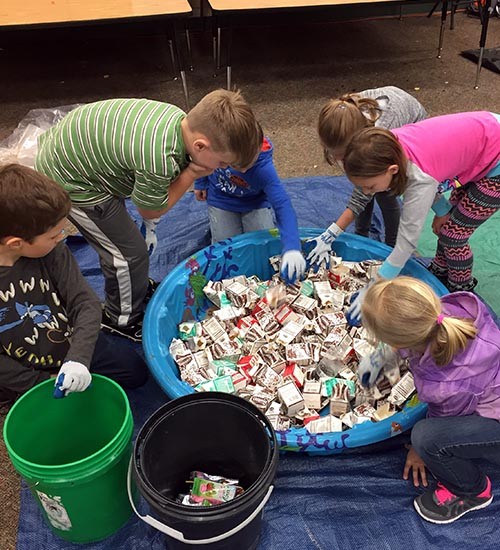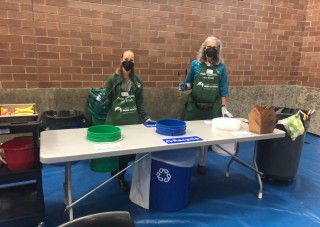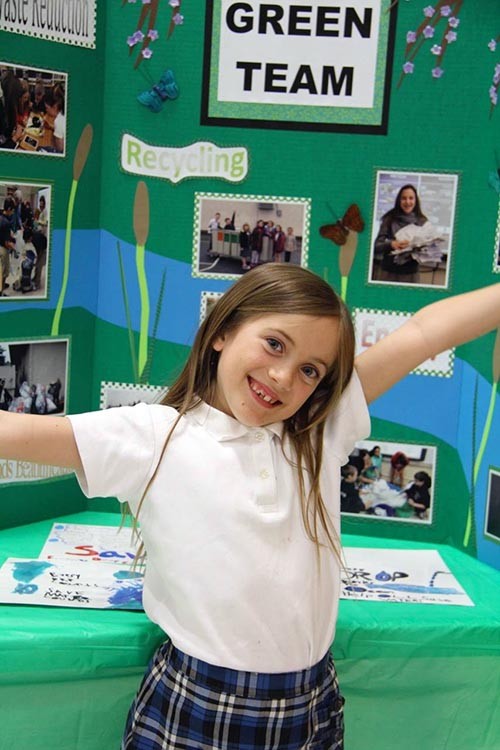Clark County Green News
How to Start a Green Team
Green Teams have proven themselves to be powerful agents of change within Clark County schools. Starting one from scratch, however, is no simple feat. If you want to establish a Green Team to make your school more sustainable but are overwhelmed by the question, "where do I start?" - you are not alone. To help you on your journey, we have gathered advice from some experienced Green Team leaders from around Clark County who have led their teams to inspire meaningful, school-wide change.
Here are five important first steps to take when creating a Green Team:
1. Establish a strong, supportive base
In order for a Green Team to make any progress, it will need a diverse network of supporters. First, it is critically important to gain approval from your school's principal, administration, and district. Then, connect with as many factions of your school's community as possible to ensure that they are aware of what the Green Team will be doing and how they can support its mission. Lunchroom staff, facilities and maintenance staff, teachers, and PTAs are all groups you should work with while setting up your Green Team. Sustainable transformation requires a coordinated effort, and cannot come from just one isolated corner of the school.
"[Plan] before you get started. Don't just have kids join and then figure out what you're doing."
Nancy Stoy, Lacamas Lake Elementary
Next, you can start recruiting student members to your Team. A good place to start with this is by identifying students who have demonstrated interest in sustainability in the classroom or are already involved with cleaning around the school and give them more responsibility. From there, it becomes important to keep them interested in Green Team work. Nancy Stoy, the Green Team leader at Lacamas Lake Elementary, recommends incentives like treats, field trips, and fun lessons like the waste relay offered by Clark County Green Schools to keep members energized. She urges you to "be creative in your work to keep [students] excited."
Furthermore, Green Team leader Ali Coker at Camas High School suggests offering volunteer opportunities that align with your Green Team's goals, such as a day spent planting trees with Friends of Trees, as a way to broaden student involvement and reach those who may not have time to formally commit to the team.
2. Start small
Looking around your school, you may see many practices that you would like to change, but it will be crucial for your Green Team to pick one specific, manageable project to focus on in the beginning. Several of the Green Team leaders we spoke to suggest performing a waste audit as your first project. Not only is it fun to watch kids get excited while digging through trash, but upon completion of your waste audit, you will have a baseline of where you are starting. You can then use this baseline to plan what your first actions will be and eventually measure the results of your Team's waste reduction efforts.
Another benefit of beginning with a waste audit is that it is visible, easy for young students to comprehend, and sparks more interest by showing the rest of the school what your Team is doing. "At the elementary age," says Ellen Lancaster at Gause Elementary, "the best incentive to join Green Team was getting to dig in the compost to look for garbage. Little kids love garbage!"
3. Hold your first meeting
Now that you have a strong membership base and an initial goal in mind, it is time to have your first official Team meeting. At this meeting, you should establish clear communication guidelines and a regular meeting schedule to ensure that all of your members are able to stay in touch. Green Team meetings often function as a forum for discussion, problem-solving, and collaboration, so it is important that your school community knows how to engage in the conversation.
It is also constructive to have a designated note-taker at each of your meetings, so you can build a continuous record of what was covered at each meeting and any prevent progress from being lost. Finally, your meeting should end with assigning action items to your members. Students enjoy being delegated responsibility, and you can energize your Team by ensuring they are actively engaged on a project. A tip from Nancy Stoy is to consider breaking up your Green Team if you have the numbers. For example, she proposes you could have four students oversee recycling in the cafeteria, three do room recycling, four do cafeteria clean-up, etc.
4. Don't be afraid to ask for help
Leading a Green Team is hard, time-consuming work, but you should not feel like you are alone in your endeavor! You have a network of supporters available at your fingertips who can offer their resources and expertise. Not only should you look within your school for people who can assist your Team, but it is also beneficial to build partnerships with other schools. By connecting with other Green Team leaders, you can learn what did and did not work for them, get ideas for future projects, and forge opportunities to team up with them to tackle big projects.
Additionally, Clark County Green Schools and EarthGen both offer a variety of free resources that Green Team leader Ali Coker encourages you to take advantage of. To name a few examples, Clark County Green Schools can provide recycling and composting materials, waste reduction lessons and activities, a presentation from master storyteller Will Hornyak, tools such as green cleaning kits, and more. EarthGen's school certification provides a helpful framework to guide your Green Team's efforts as well. Your Team can choose a project from among seven environmental categories and track your progress using a convenient report card. EarthGen also has a carbon calculator tool which can be used to determine your school's initial carbon footprint and evaluate its change over time. Pursuing EarthGen's certification process can help you develop a long-term plan for your Green Team once you have identified your initial near-term actions.
Avoid creating more work for yourself than necessary - we are here to help!
5. Celebrate success!
Changing your school's sustainability culture is challenging and does not happen overnight. Remember to celebrate your achievements (no matter how small) to keep the Team motivated and excited about the work you're doing. Social media platforms, for example, are useful tools for highlighting your events, projects, and accomplishments. Students, especially high schoolers, will enjoy following your progress via their Instagram, Twitter, or Facebook feeds. However you choose to celebrate, be sure to reward yourself and your students for taking the initiative to make a difference. Empowering your students to continue pursuing environmental sustainability will have a huge impact both in your school and beyond!
When you subscribe to the blog, we will send you an e-mail when there are new updates on the site so you wouldn't miss them.






